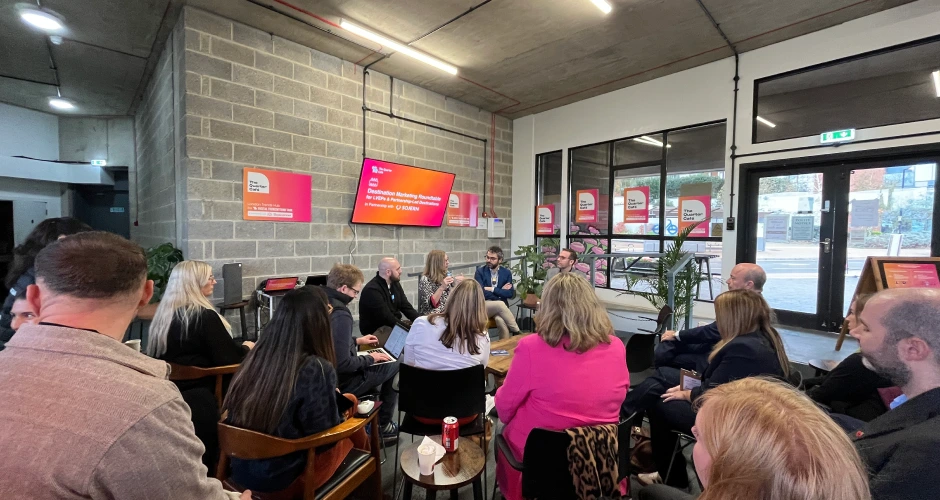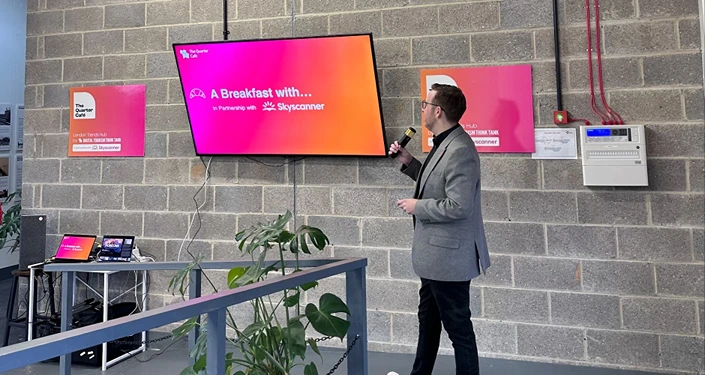In episode 1 of our "Tour Tech: Your 5 Weekly Takeaways to Tourism Success" podcast series, part of the EU-funded Tourbit project, we learn about how technology can help destinations obtain timely and reliable feedback from their visitors. This article explores the successful collaboration between Visit Pyhä-Luosto, a Destination Management Organisation (DMO) in Finnish Lapland, representing the regions of Pyhä and Luosto and Salmi Platform, a data analysis company specialising in tourism. It delves into how their collaboration has transformed the DMO's operations and enabled it to access new data to influence strategic decisions. It also explores the challenges and benefits of utilising data to enhance the tourist experience and highlights the significance of responsible data practices within the tourism industry.
Identifying the Need for Data-Driven Insights
Anu Summanen, Executive Manager of Visit Pyhä-Luosto, recognises the critical need for customer feedback to improve their service offerings. However, the role as a DMO, coupled with the dispersed nature of services across the region, presents a challenge in establishing an effective data collection system because Visit Pyhä-Luosto lacked the customer database to directly ask visitors for their feedback. Salmi Platform therefore presented a perfect solution for obtaining valuable insights to develop the region.
Salmi Platform: Providing a Comprehensive Solution
Wille Markkanen, Managing Director of Salmi Platform, describes their solution as gathering tourism data beyond the scope of official statistics, focusing on the unique insights obtainable only from tourists themselves. Their online survey is translated into 12 languages, helping to capture data from a wide range of source markets. This data encompasses various aspects such as:
- Feedback: Capturing opinions of positive or negative experiences and suggestions for improvement.
- Economic Impact: Analysing tourist spending, motivations, demographics, travel methods and accommodation preferences.
- Environmental Impact: Assessing the carbon footprint of travel and the wider travel chain.
- Social Impact: A recent addition, this component incorporates the perspectives of local residents about tourism and their relationships with tourists.
Collaboration and Implementation Strategies
The successful collaboration involved understanding Visit Pyhä-Luosto's specific requirements and data needs, customising the data collection process accordingly and ensuring the data's quality. Visit Pyhä-Luosto distributes the survey, but Salmi Platform handles the technical aspects, making collaboration between both organisations essential.
Tourists were reached through a multi-channel approach, including through Visit Pyhä-Luosto's website, social media platforms, newsletters and partnerships with local accommodation and activity providers. The data collection process and analysis are automated, with reporting through a Microsoft Power BI data portal, enabling instant access for Visit Pyhä-Luosto to monitor customer satisfaction and segment based on different customer profiles. Salmi Platform also prepares detailed analytical reports, either annually or at the end of each season, highlighting the key insights to further clarify key issues identified by visitors.
Importantly, Visit Pyhä-Luosto shares the data with its members, aligning with the belief that all operators need to have the most up-to-date information about visitor behaviour trends. Visit Pyhä-Luosto summarises the data to help businesses develop and improve their products in accordance with the desires of travellers. Meanwhile, through API connections, the data can be integrated into other platforms, enabling partners to visualise the data within their internal platforms. In this regard, Wille highlights the importance of responsibly sharing data, focusing on how anonymising data protects client security.
Unveiling the Power of Data-Driven Development
Anu emphasises the tangible benefits of collaborating with Salmi Platform, integrating weekly monitoring of the data into the DMO's internal processes:
- Real-time monitoring: Enables immediate problem-solving based on feedback.
- Long-term insights: Informs strategic development plans regarding the management of trails and public transportation infrastructure.
- Data-driven decision-making: Visitor sentiment data is persuasive and provides a common understanding for stakeholders, including businesses and policymakers, facilitating collaboration for aligning destination development plans and the ideal channels for marketing investment.
Of particular note, Visit Pyhä-Luosto, with two resorts in one destination was able to quantify the volume of visitors that visited both resorts, which Anu regards as the most important insight. From this data, which validated internal beliefs, Visit Pyhä-Luosto acknowledged the strong need to improve public transport between both resorts to enable travellers without cars to experience the diverse offers of both resorts. The data also helped to show the two municipalities of Pyhä and Luosto that decisions shouldn't be made individually and the destination needs joint actions from both municipalities to develop effectively.
It takes time to be successful in implementing big changes. Anu explains that the collaboration was originally seen as a one-off project, but with the potential of obtaining high quality feedback observed, Visit Pyhä-Luosto has committed to monitoring visitor sentiment more regularly to continuously improve the destination.
Broader Impact and Future Potential
Wille underscores the broader potential of this collaborative approach:
- Enhancing tourist satisfaction: By comprehending tourist preferences and addressing their needs, the overall tourism experience can be significantly improved.
- Optimising economic impact: Attracting high-value customers and allocating marketing resources efficiently leads to better economic outcomes for the destination.
- Minimising environmental impact: Promoting sustainable travel practices and influencing relevant authorities contributes to a more environmentally responsible tourism sector.
Key Takeaways for SMEs and DMOs
DMOs and other tourism businesses should always be alert to new opportunities, where technology can be used to drive innovation and influence strategic decisions. Collaboration is essential to this process, where organisations utilise each other's strengths to produce useful outputs. In this light, technology providers can be extremely beneficial within the tourism sector by providing technical expertise to reduce the fragmentation in tourism, while DMOs have the strategic vision and knowledge of the sector to understand how to implement the insights obtained and share them amongst the entire industry within their destination.
When deciding to use new datasets and sources of information, it's important to first have a clear purpose to understand the reasons for collecting new insights and how they will be used. For example, through digital tools such as real-time monitoring, organisations can get a better understanding of the day-to-day impact and gain insights into customer behaviour, satisfaction levels and potential improvements. However, collecting data needs a long-term perspective and shouldn't only be undertaken for one-off projects. It's important to see how indicators change over time and if the actions undertaken by organisations are having a positive impact. Meanwhile, once data quality has been ensured for current indicators, new datasets can be experimented with to continuously gain new insights.
Collecting a combination of visitor sentiment and impact data, linked to demographics, enables organisations to access very granular insights, influencing their marketing strategies and the campaigns developed so that they are suited to the types of visitors targeted. Having a clear overview of both visitors' and locals' opinions of tourism also helps identify priorities and brings stakeholders together alongside a common vision for destination development.
By guaranteeing anonymity, customers are more willing to share their opinions, facilitating the ability to segment data by different groups of visitors. Maintaining trust and data integrity requires adherence to responsible data practices, ensuring anonymity and ethical use of information collected. Establishing API connections is also a fundamental consideration that cannot be overlooked given the need for data to be transferred and visualised across the broad range of systems used by tourism organisations so that it is accessible to everyone.
The partnership between Visit Pyhä-Luosto and Salmi Platform exemplifies the transformative power of data-driven decision-making in the tourism industry. By embracing collaboration, responsible data practices and a commitment to continuous improvement, destinations can create more fulfilling experiences for tourists, optimise their operations, and contribute to a more sustainable future for tourism.
Here are the five key takeaways:
- Gathering market data and direct visitor feedback is crucial in order to improve the destination, with DMOs playing a role in infrastructure development and monitoring the environmental impact.
- Data plays a pivotal role in facilitating excellent collaboration between different stakeholders across the industry.
- Real-time monitoring not only helps with day-to-day operations, but it also helps us to get perspective in the long run.
- Leveraging data and collaboration helps to drive innovation, which in turn helps shape the future of the tourism industry.
- Continuous improvement and adaptation is essential for us to thrive in a digital age.
The podcast series is part of the Tourbit project, co-funded by the EU's COSME programme, with the support of the Catalan Tourist Board, Barcelona Chamber of Commerce, Paris & Co, Arctur Doo, Hub Brussels, Iceland Tourism Cluster, Lapland University of Applied Sciences and NEST - Tourism Innovation Center.






.svg)
















.webp)
